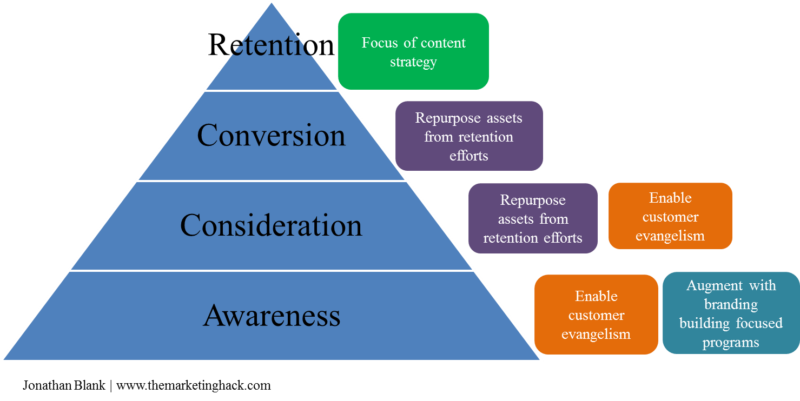The Content Relationship: Flip The Funnel On Your Content Strategy
Want to develop a content strategy that differentiates your brand from the competition? Columnist Jonathan Blank explains how.
I wish my former AP English teacher would consider a second career teaching where to focus content strategies. Without knowing it, she developed and executed on a content strategy that motivated students to attend her class week after week.
I bet you wouldn’t mind your customers looking forward to interacting with your brand at least once a week. With some adjustments to the mandate for content marketing at our companies we can make a significant difference in customer retention.
Unfortunately, too many brands are failing to develop content programs specifically designed to bring customers back again and again to the proverbial brand classroom.
B2B marketers put five goals ahead of customer retention for their content marketing efforts, according to the 2015 B2B Content Marketing Trends Report by the Content Marketing Institute and MarketingProfs.
There’s a great opportunity to develop a content strategy that differentiates your brand from the competition by flipping the funnel and focusing your efforts on customer retention and customer evangelism.
If you prioritize customer retention and evangelism with your content strategy, you’ll essentially build content into your products and services and strengthen the value of your core offerings.
Here’s how to make the case to your CMO that you and your team should focus on retention.
Correlate Content Consumption With Product Usage
You probably know if visitors which subscribe to your newsletters or download your e-books are better leads. However, do you know if they are better long-term customers?
If you are developing and distributing the right content, your customers should understand how to optimize their use of your products. As a brand-side marketer, I’ve shown the impact of content on product usage through three different ways.
- Subscribers Versus Non-Subscribers – Take the customers in your database who have opted into a regular content program and compare their average monthly usage of a product compared to customers who have not opted in. This type of analysis is best for programs that are centered around a blog or newsletter. You can also use Facebook’s Custom Audience targeting capability to ascertain what portion of your top users are engaged with your Facebook content.
- 30 Days Prior Versus 30 Days After – I love this analysis for showing senior management how content can make an immediate impact on key business metrics. We all know that content marketing is an approach that takes time to deliver ROI. However, content programs can quickly boost product or service usage. Through a combination of data from your marketing automation software and your customer relationship management software, you can compare the 30 day averages prior to a content event (IE a Webinar or video view) with the 30 day average after the event.
- Customer Satisfaction Levels – Send your boss a report that compares customer satisfaction survey data for those customers who have opted-in to content programs compared to those who have not opted-in. Content programs can provide customers with the education and training that are necessary for them to feel that you have done your part in the partnership.
With it well-documented that it is more cost-effective to keep current customers than acquire new ones, these metrics are as meaningful for our content strategies as metrics on cost-per-lead and sales-cycle time.
Or, as my AP English teacher told me, “kid, I don’t care if you are smart enough to get in the door. I only care if I can get you to read great literature over and over again.”
Build A Bridge Between Customers
There’s a phrase that your CEO and CMO love to say to current customers. No, it’s not “hey it’s time to talk about a new contract/product/upgrade.” It is “hey, I have a great opportunity for you.”
Through customer-only content programs, you can give your C-Suite the ability to use that phrase again and again. They can offer top customers the opportunity to strengthen their personal thought leadership and gain access to other leaders in the field.
More importantly, you can develop a content strategy that delivers exclusive insights to your customers that they cannot get anywhere else.
Since you probably have a detailed profile or your top customers, this is a great place to focus your content marketing efforts. You intimately understand their pain points and can use that information in crafting and distributing content with (not to) them.
Start by capturing and publishing the insights of your top customers. Then, distribute that content to your other customers. Get their feedback. Repeat.
When it comes to picking content contributors, start with your top customers. Not your brand. Not influencers. They’ll get involved later.
To be clear, I’m not urging you to pump out more case studies. I’m recommending that you provide your top customers with a platform to share their point of view on industry challenges and their strategic approaches to overcoming them.
Many of your top customers will share your brand’s point of view on these challenges. That’s partially what drew them to your brand.
Your content strategy should enable these customer contributors to converse with each other and other customers. I want to see the word “access” all over your content strategy document.
With this access, customers will have an incentive to regularly contribute and will think twice about moving over to a competitor. They’ll want to keep their access to peers and industry thought leaders.
Plan To Scale Your Exclusive Content
I’m urging content strategists to flip the funnel, not banish awareness and consideration. You can and should re-purpose some content from these programs to promote brand awareness and lead generation.
Take a page from Jon Stewart for this. He asks his top guests to stick around and “we’ll take the rest of this interview to the web.” You should ask your contributors to stick around and provide more high level content for your prospects and leads.
Within your strategy document, you should have a plan for getting enough material from contributors to develop exclusive customer-only content and non-exclusive content. You can achieve this in a couple of ways:
- Taking The Same Raw Content & Producing Two Content Assets – Develop more interactive features, more in-depth commentary or a section on how to apply the advice using your product for the customer-only version of the content asset.
- Pairing Content Assets – Amend assets you already have developed and archived in some manner for the topics at hand. Then, communicate the offerings in a manner that showcases how they can be used together to solve a specific issue.
- Offering Additional Q&A Opportunities – Invite customers to chat sessions with your content contributors or other experts.
Some examples of what your team could develop and distribute based on this strategy include video highlight reels of webinars, interactive worksheets based on contributor interviews, and exclusive access to discussion groups.
We’ll go more in-depth into customer evangelism in a future column. Your strategy should incentivize contributors to share content among their colleagues and other audiences.
This can be done by providing them with templates for blog and social media posts, as well as exclusive access to thought leaders within your company.
However you decide to scale your efforts, your CMO should know you have a plan to scale and that your customer retention efforts will not be siloed off from everything else you are doing in content marketing.
My AP English teacher’s job depends on her ability to get students to sign up for her class. However, she doesn’t focus on making a case for her class. She focuses on high attendance from the students that already have signed up and their experience in class. With this focus, I have a feeling her job is safe.
If you focus on customer retention, I think your content marketing programs will be secure as well.
Opinions expressed in this article are those of the guest author and not necessarily MarTech. Staff authors are listed here.
Related stories


